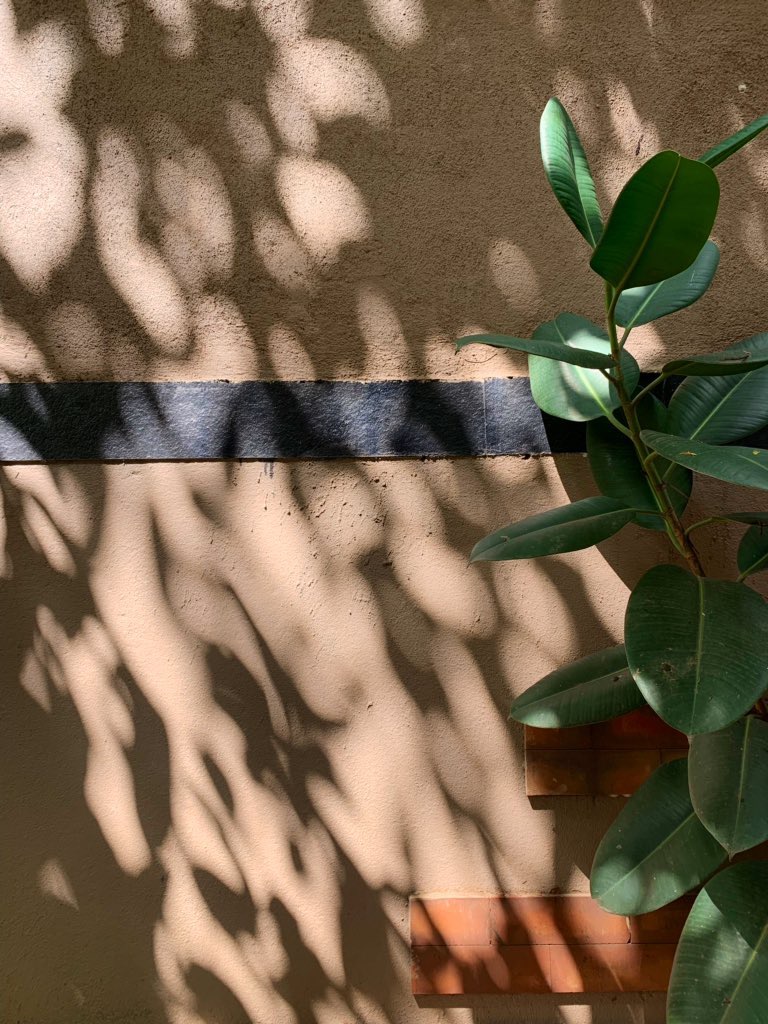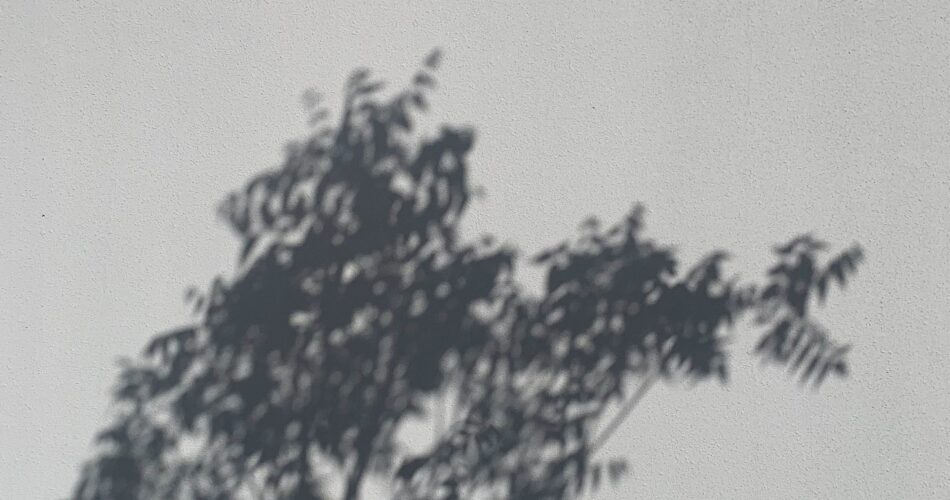Priyanka Sacheti | April 2023
‘…It’s simple science, really,
how opaque objects
placed in the path of light rays
do not let the light pass through.
But there’s something so beautiful
and temporary
about the giant spectral blooms.’
Evanescent, Rosemary Trommer
It is a mellow Bangalore winter morning. I am sitting at my usual writing spot, overlooking the balcony; I am ostensibly trying to write but my eyes stray towards the plants which have recently come to live there. My botanist and gardener mother is visiting and has planted a garden here, which includes marigold, turmeric, snake, and cosmos plants along with reviving the hibiscus and bougainvillea, which I had bought a few months ago but had woefully languished under my inexperienced gardening eye. But it is not just the plants which catch my eyes today; I am tracing the shadows that the marigold plant stencils upon the floor, the turmeric and bougainvillea leaves joining in the conference of shadows. It is but a brief moment of shadow theatre though; the sun is already inching its way up the sky and the light, gradually retreating from the balcony, like the tide. But I am glad that there was light in the first place – and for the shadows that have come of it.

I became a shadow collector only after I moved to Bangalore six years ago, photographing shadows wherever I saw them. The first year I called the city home made me realise how much of the year it spent shrouded in monsoon gloom, the sun often becoming a rarely glimpsed guest for many months. As someone brought up in Oman, accustomed to what I then dismissed as the monotony of one sunny day after another, it was so dispiriting to wake up to a succession of charcoal mornings, the clouds thickly banked upon the sky, as if insistent on denying the presence of the sun altogether. The fact that I lived in a first floor apartment which received almost no light further exacerbated the situation. It was the first time I began experiencing what would become an annual iteration of the Seasonal Afflicted Disorder (SAD), the acronym resonating more deeply than ever.


For the longest while, I used to associate shadows with darkness; after all, the dictionary definition of a shadow baldly states that it is ‘a dark shape on a surface that is made when something stands between a light and the surface.’ However, whenever I encounter the word, ‘shadow, I also hear in my head the voice of a watercolour artist whom I used to take lessons from as a child in Oman. During one class, when I was about to paint shadows in opaque grey, a grey so dark that it was almost black, she gently took away the brush from my hand and began to conjure up an alternative reinterpretation of shadows. In her hands, shadows became a symphony of grey and blue and mauve and violets, the color of a bruise but also the one of a faded jacaranda, pressed in between the pages of a book. And indeed, when I looked up her paintings afterwards, most of them depicting Omani landscapes and architecture, the shadows in her works are both a dazzling celebration of the desert sunlight as well as brilliant entities in their own right. Perhaps, it was then I started to see shadows as something to admire and gravitate towards, rather than continually escape.


I know by now that Bangalore’s sunny days begin from late October and last till May – and it is then that I savour the sheer abundance of sunshine and the endless blue skies that these months afford me. It was perhaps during my first winter in the city that I found myself photographing shadows, their existence reminding and comforting me that light was around and that too in aplenty. And given that we lived in a relatively verdant apartment compound, I became particularly drawn towards and capturing the shadows that plants cast upon the rust-hued earth. I had already been eagerly discovering the many and new kinds of plants that I was encountering in Bangalore; their shadows doubled my appreciation for them, making me contemplate them in multiple kinds of ways. And so, as I walked from one place to another or glimpsed the city flowing past me during commutes, I eagerly drank in the sheer variety of plant shadows that I continually witnessed, finding something new to dazzle me each time.

Over the years, as I have become more familiar with the city’s foliage, I have observed that each plant has its unique shadow language, the shadow leaf alphabets assuming the form of hieroglyphs upon the ground for the viewer to discover and try to decipher.
The peepuls tremble, with their dusty pink leaves of spring and summer’s bright green.
The tabebuias paint more forlorn strokes when they have lost their leaves and await the flowers.
The monstera jutting out from a garden spills over to the street, both in leaf and shadow.
Inside the quivering nest of the raintree canopy’s leaf shadows, we find a mirror reflection of its vast, embracing beauty.
A plant stencils its blooms upon the white walls.
In my old apartment compound, there was a fig tree which grew opposite a brick wall. Sometimes, it was not enough to have just still pictures of shadow art; I would take videos of the fig tree leaves’ shadow dances on breezy mornings, finding in them the much needed moments of meditative pause that I had often experienced while studying and capturing the shadows. These videos would provide succour for those gray days in the future, when I would have to switch on the lights first thing in the morning, when sun seemed a distant, mythical creature. Looking at those videos, I would revel in the luxury of light, both light and shadows slathered upon the surfaces, like butter.

Perhaps, it is apt that it was in midst of discovering new plants and trees and capturing their still and moving shadows that I stumbled upon the Japanese word, ‘Komorebi’ which refers to the ‘light that filters through tree canopies as well as the dancing spots created when these shafts of light hit the forest floor.’ I was in a time and place when I could truly appreciate the resonance of the word.
Once you begin to walk down a path, you find yourself exploring others budding from it, like river tributaries. The more I contemplated plant shadows, the more I found myself thinking about something which I had previously never considered: the byproduct of shadows, shade. This realisation was in large part due to Bangalore’s large trees, particularly the shade offered by the raintrees’ sprawling canopies. During my initial visits to the city, I couldn’t help continually gaze up at those sky-embracing canopies, the likes of which I had never seen before. Afterward, I learned that the raintree’s canopy and the fact that it grew quickly helped lower the surrounding temperature, contributing towards the city’s famed salubrious climate. Growing up in a desert city, Muscat, where there were few trees and shade was a rarity, it took me a long while to realise how shade can be a luxury in itself, especially in urban areas; trees play so many roles and functions in a city and the shade they cast provide a cool refuge for the city inhabitants during the warm months. In this piece, Sam Bloch delineates the idea of ‘shade as a civic resource that is shared by all. In the shade, overheated bodies return to equilibrium…In a physiological sense, they are themselves again.” The intertwining of shadows and shade is essential in multiple ways and more so than ever in a world which is experiencing various uncomfortable manifestations of global warming.

In the years that I have called Bangalore home, I have sadly been witness to the destruction of several trees, especially those that had become a part of the map of my immediate neighbourhood. I recall seeing closely over a period of days the prolonged and painful destruction of a raintree, its eventually evicted stump radiating a million roots reminiscent of a pillar of an underground palace excavated from the earth. Every time I passed the fallen tree, I thought of the multiple losses associated with the cold, brutal reality of the fact that it would simply no longer stand in the spot it had called home for decades. I thought of the countless who had made the tree their home and now been rendered homeless. I thought of how the tree provided shade to the many who came to rest in its cool presence, taking a breather from the urban chaos or to set up temporary food cart, ironing stall, a streetside shop. When I walked past the cut tree, I fancied I could already see the ghost shadows lying thickly upon the ground but I knew it would not take long for them to fade from memory, both mine and that of the city.

I dread to imagine what it would be like to inhabit a land of neither shadow nor shade. After all, it was only in shade that I could truly appreciate the beauty of shadows, its many shapes, patterns, and textures. Unlike the monolith shadows cast by buildings or inanimate urban structures, plant shadows are a constantly changing, lively, dancing creatures; in their shade, I have come to realise that the shadow art is as important as the artist itself. And I will always continue to collect that art, forever being a shadow collector.
_________________________

Priyanka Sacheti is a writer and poet based in Bangalore, India. She grew up in the Sultanate of Oman and was educated in the United Kingdom. She has published widely about gender, art, culture, and the environment for various Indian and international publications.
Her literary work has appeared in many literary journals such as Barren, Dust Mag Poetry, Common, Popshot, Lunchticket, and Jaggery Lit as well as various past and forthcoming anthologies. She is currently working on a poetry collection. She can be found as @atlasofallthatisee on Instagram and @priyankasacheti on Twitter.
_________________________
Find The Mean Journal on Instagram @MeanPepperVine

Beautifully written! You have brought alive the beauty and poignance of plant shadows. What they give when they are around and what we lose when they disappear. And some of those photographs made me gasp at the beauty of it.
Hi Gowri! Thank you so much for reading…it’s a subject close to my heart and so glad that the words and images resonated with you:)